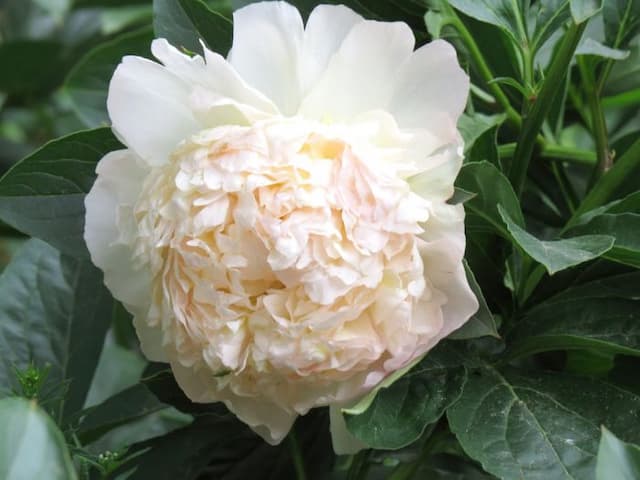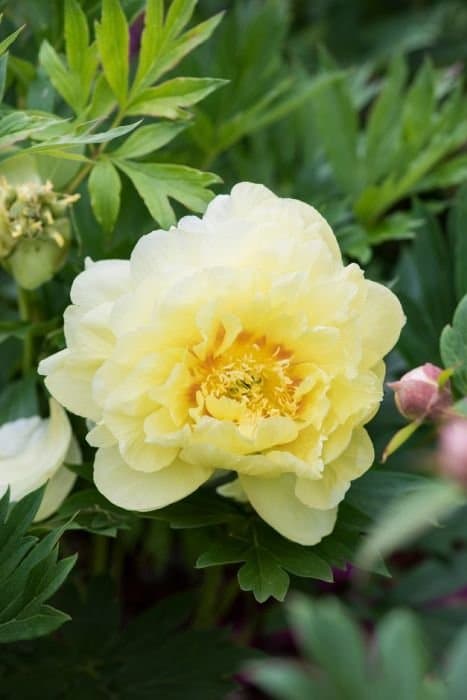Chinese Peony Paeonia lactiflora 'Doreen'

ABOUT
The Paeonia lactiflora 'Doreen', commonly known as the Chinese peony 'Doreen', is a perennial plant known for its stunning and distinctive flowers. This variety produces large, full blooms that are a luscious shade of pink, with multiple layers of delicate, silky petals that loosely gather to form a round shape. The outer petals may be lighter in color, providing a soft, romantic fading effect towards the edges. At the center of each bloom, a cluster of golden-yellow stamens creates an appealing contrast, adding depth and interest to the flower's overall appearance. The foliage of the Chinese peony 'Doreen' is also quite attractive. It boasts deep green leaves that provide a lush backdrop for the spectacular blossoms. The leaves are divided into leaflets that have a smooth or sometimes slightly wavy margin, and they are typically glossy, which further enhances the visual appeal of the plant. Blooming in late spring to early summer, 'Doreen' offers a delightful display when the flowers are at their peak. Additionally, the plant has a pleasant, subtle fragrance that can waft through the garden, especially on warm, sunny days, making it a favorite among gardeners who appreciate sensory experiences. Chinese peony 'Doreen' can serve as an excellent focal point in garden beds and borders, or it can be planted in groups for a more impactful floral show. Its charming flowers are also highly regarded for use in cut flower arrangements, bringing a touch of elegance and beauty to any indoor space.
About this plant
 Names
NamesFamily
Paeoniaceae
Synonyms
Chinese Peony, Common Garden Peony
Common names
Paeonia lactiflora 'Doreen'.
 Toxicity
ToxicityTo humans
Peony, specifically the variety 'Doreen', is not considered highly toxic to humans. However, like many plants, it may cause mild upset stomach, diarrhea, or skin irritation in some individuals if ingested or handled excessively. It is always good practice to avoid eating ornamental plants due to their unknown effects on human health. If large quantities are consumed, the possibility of more severe gastrointestinal distress or other symptoms could arise, necessitating medical attention.
To pets
Peony 'Doreen' is also known to be potentially toxic to pets if ingested. While not one of the most toxic plants, it can still cause symptoms such as vomiting, diarrhea, and drooling in cats and dogs. If you suspect your pet has ingested parts of a peony plant, it is advisable to contact your veterinarian, as they might require symptomatic supportive care.
 Characteristics
CharacteristicsLife cycle
Perennials
Foliage type
Deciduous
Color of leaves
Green
Flower color
Pink
Height
2-3 feet (0.6-0.9 meters)
Spread
2-3 feet (0.6-0.9 meters)
Plant type
Herb
Hardiness zones
3-8
Native area
Asia
Benefits
 General Benefits
General Benefits- Aesthetic Appeal: Paeonia lactiflora 'Doreen', commonly known as peony, adds beauty to gardens with its large, showy flowers that come in a soft pink hue, offering a visually appealing display during blooming season.
- Longevity: Peonies are known for their long lifespan, often living for decades and providing consistent blooms year after year with minimal maintenance.
- Fragrance: The peony's fragrant flowers produce a pleasant scent that can enhance the sensory enjoyment of a garden space.
- Pollinator Friendly: Peonies attract pollinators such as bees and butterflies, which are important for the health of your garden and the environment.
- Cut Flowers: The blooms of peonies make excellent cut flowers, lasting for a week or more in a vase, and are often used in floral arrangements and bouquets.
- Versatility: Peonies can be used in a variety of garden designs, from borders and flower beds to formal landscapes and cottage gardens.
- Drought Tolerance: Once established, peonies can withstand periods of low water, making them suitable for gardens in drier climates or for gardeners seeking water-wise plants.
- Cold Hardy: This plant is cold hardy and can survive in colder climates, making it a great choice for northern gardeners.
 Medical Properties
Medical Properties- Anti-inflammatory: Paeonia lactiflora has been used in traditional medicine for its potential anti-inflammatory effects.
- Analgesic: It may possess analgesic properties that can help alleviate pain.
- Immunomodulatory: Some components of Paeonia lactiflora may have effects on the immune system.
- Antispasmodic: It has been used to reduce muscle spasms.
- Antioxidant: The roots contain compounds that exhibit antioxidant activity.
 Air-purifying Qualities
Air-purifying QualitiesThis plant is not specifically known for air purifying qualities.
 Other Uses
Other Uses- Paeonia lactiflora, commonly known as the Chinese peony, can be used in floristry for bridal bouquets and wedding decorations due to its large, showy, and fragrant flowers.
- The petals of the Chinese peony can be crystallized with sugar and used as edible decorations for cakes and pastries, offering a light floral flavor and a touch of elegance.
- Dried Chinese peony petals can serve as a natural dye, infusing fabrics with soft pinks and reds when used in a dye bath.
- Chinese peony plants can be used in landscaping to create a border or as a focal point in a garden due to their attractive foliage and flowers.
- The fallen petals of the Chinese peony can be collected to make a natural, fragrant potpourri which serves as a freshener for closets and drawers.
- As a subject in art and photography, the Chinese peony's full blooms are celebrated for their beauty and complexity, making them a popular choice for botanical illustrations.
- Chinese peony petals can be infused in oils to create natural, floral-scented body oils for massage or skincare purposes.
- The plant's lush foliage can be incorporated into green roofs or living walls for urban gardening, adding texture and seasonal flowers.
- Their sturdy stems and full blooms allow Chinese peonies to be used in craft projects, such as making handmade paper or adding natural elements to wreaths and other decorations.
- Chinese peony blossoms can serve as a natural confetti for outdoor celebrations, offering a biodegradable and environmentally friendly alternative to synthetic confetti.
Interesting Facts
 Feng Shui
Feng ShuiThe Peony is often used in Feng Shui to promote love and romance, and is especially beneficial when placed in the southwest corner of a garden or room.
 Zodiac Sign Compitability
Zodiac Sign CompitabilityThe Peony is not used in astrology practice.
 Plant Symbolism
Plant Symbolism- Beauty: The Paeonia lactiflora 'Doreen', commonly known as the Peony, is often associated with beauty due to its large, full blooms and range of colors.
- Prosperity: Peonies symbolize prosperity and are often used in celebrations such as weddings to wish wealth and honor to the couple.
- Romance: With its lush petals, the Peony represents romantic love and is frequently used to express affection and passion in a relationship.
- Honor: The beauty and rarity of the Peony also make it a symbol of honor and high social status.
- Wealth: They've historically been associated with wealth, not just due to their use in prosperous occasions but also because of their lush, abundant look.
- Compassion: Peonies may denote compassion as they are often shared to convey comfort in times of distress or as tokens of affection.
- Good Luck: In some cultures, the Peony represents good luck and is viewed as an omen of good fortune.
 Water
WaterPeony 'Doreen' should be watered deeply once a week during the growing season, ensuring the soil is moist but not waterlogged. This translates to about 1 inch of water weekly, which can be approximately 0.624 gallons per square foot if you're watering an established plant in the garden. During hotter, dry spells, the frequency may need to increase to twice a week. Ensure water is applied directly to the base of the plant to keep the foliage dry, which helps prevent fungal diseases. Adjust watering during the fall to encourage the plant to prepare for dormancy, decreasing the amount as temperatures drop.
 Light
LightPeonies like 'Doreen' thrive in full sunlight, requiring a minimum of 6 hours of direct sun daily. They perform best when planted in a spot that receives morning sunlight and some partial shade in the hottest part of the afternoon. However, too much shade can lead to weak stems and fewer blooms, so prioritizing a location with good morning light and some protection from intense late-day sun is ideal.
 Temperature
TemperaturePeony 'Doreen' can tolerate a broad range of temperatures - they require cold winters with temperatures between 0°F and -20°F to undergo proper dormancy, which is crucial for blooming. During the growing season, peonies prefer a temperate climate and perform best with temperatures ranging between 65°F and 75°F. They can survive short periods of higher summer heat if they receive adequate watering, but prolonged heat above 80°F may reduce flowering performance.
 Pruning
PruningPrune peony 'Doreen' to remove spent blooms after flowering to maintain plant health and appearance. In late fall, after the foliage turns brown, cut the stems down to about 3 inches above the ground to prepare for winter and help prevent disease. Peonies do not require extensive pruning throughout the growing season, but removing any damaged or diseased foliage as needed can help promote vigorous growth.
 Cleaning
CleaningAs needed
 Soil
SoilPeonies prefer well-draining, fertile soil with a pH of 6.5 to 7.0. For Paeonia lactiflora 'Doreen', mix garden soil with compost and perlite to enhance drainage and fertility.
 Repotting
RepottingPeonies, including Paeonia lactiflora 'Doreen', are long-lived perennials that do not need frequent repotting. They can remain undisturbed for many years unless they become overcrowded.
 Humidity & Misting
Humidity & MistingChinese peonies like Paeonia lactiflora 'Doreen' are tolerant of a wide range of humidity levels and do not require specific humidity adjustments in the garden setting.
 Suitable locations
Suitable locationsIndoor
Peonies rarely thrive indoors; they need cold to bloom.
Outdoor
Plant in sunny spot with rich, well-draining soil; ensure winter chill.
Hardiness zone
3-8 USDA.
 Life cycle
Life cyclePaeonia lactiflora 'Doreen', commonly known as the Chinese Peony 'Doreen', begins its life cycle when the seeds germinate in late winter to early spring. Emerging shoots push through the soil and develop into stems with compound leaves. Throughout the spring, foliage matures and by late spring to early summer, the plant produces large, often fragrant, showy flowers ranging from white to pink. After flowering, the plant sets seeds in pods that mature by late summer and then disperse. With the onset of autumn, foliage begins to yellow and the plant enters a period of dormancy, with above-ground parts dying back. The plant's life cycle continues as it overwinters with its root system intact, ready to regenerate come next spring.
 Propogation
PropogationPropogation time
Early Spring
The Paeonia lactiflora 'Doreen', commonly known as the Chinese peony 'Doreen', is typically propagated through division, which is best performed in the fall after the plant has gone dormant. To propagate by division, you should carefully dig up the plant and wash off the soil to reveal the root structure. Look for natural divisions in the roots and gently separate them, ensuring each division has at least three to five eyes, which are the dormant buds that will become next year's shoots. Each division should then be replanted in well-draining soil to a depth where the eyes are about 1 to 2 inches (2.5 to 5 cm) below the soil surface, allowing ample space for the roots to spread. Water the newly planted divisions thoroughly and expect them to bloom in one to two years as they become established.






![Peony [Red Sarah Bernhardt]](/_next/image?url=https%3A%2F%2Fplants-admin.emdemapps.com%2Fimages%2Fplants%2F%2Fimages%2F604b5369d170e.png&w=640&q=75)


